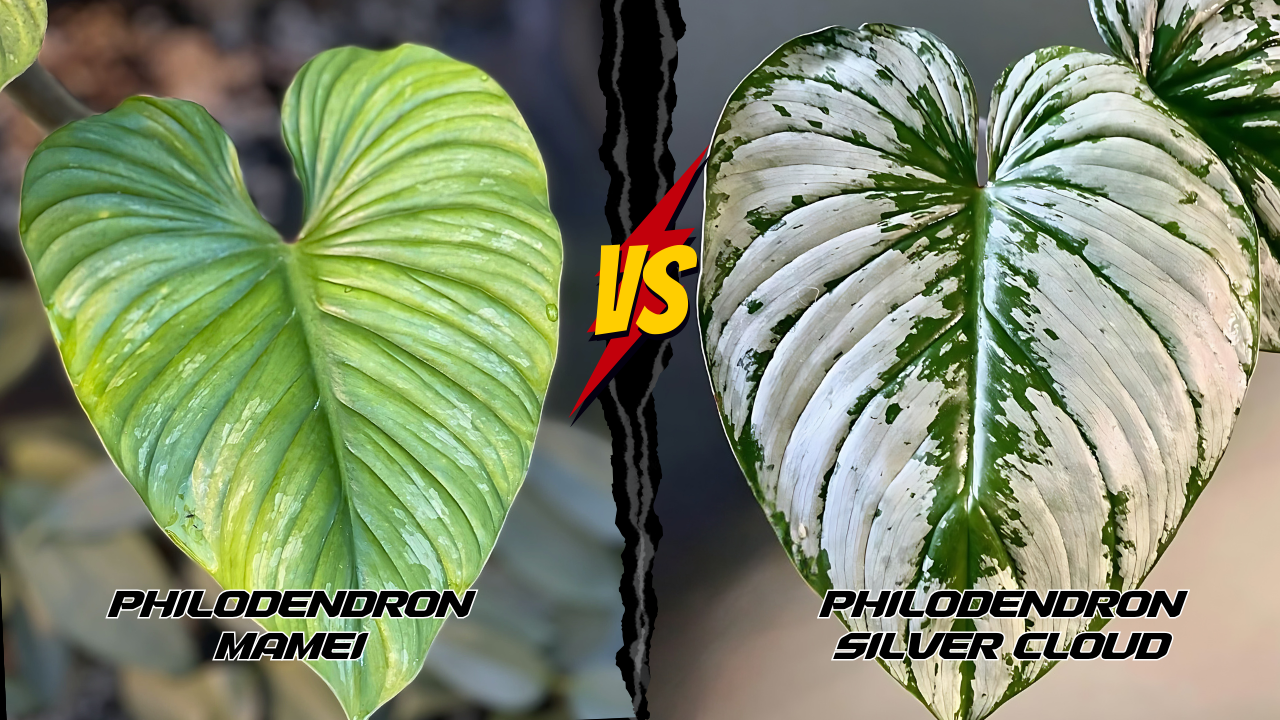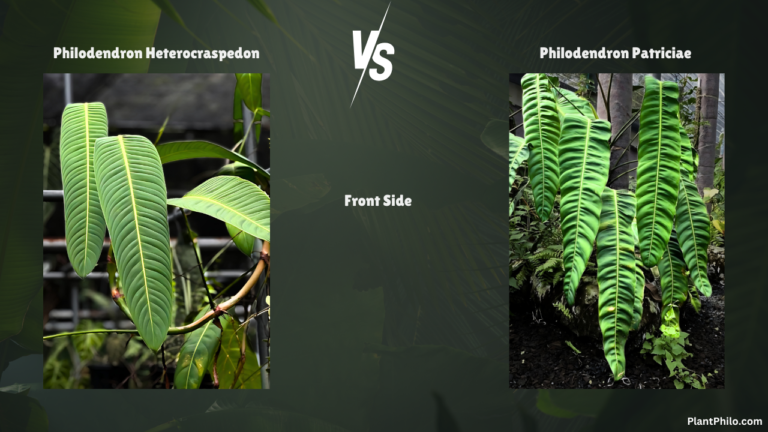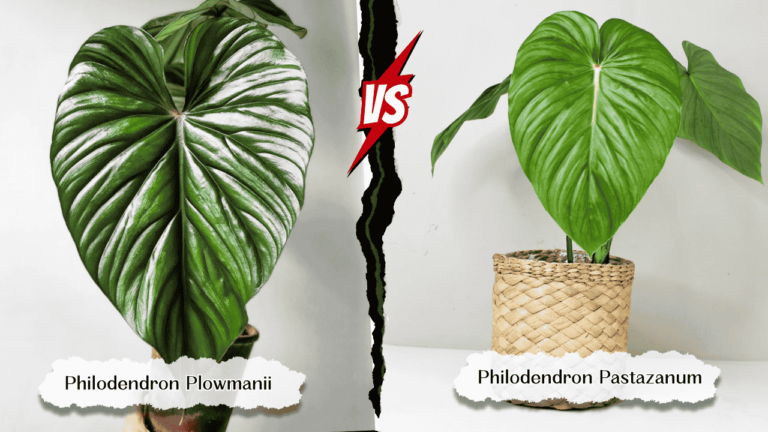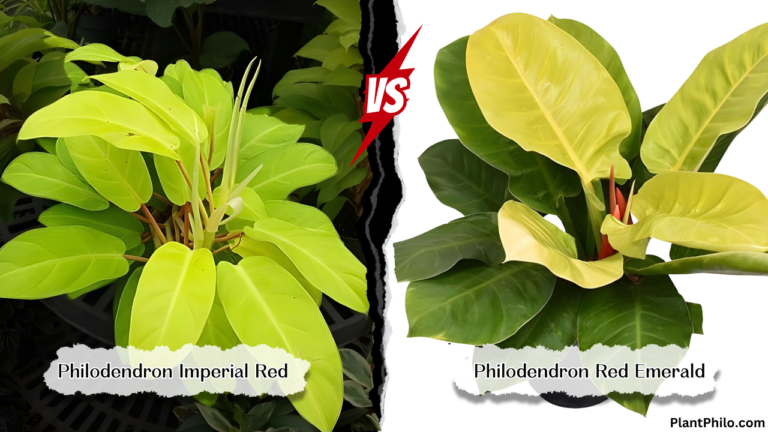Philo Mamei vs. Silver Cloud – may look like twins, but don’t be fooled!
Philodendron Mamei and Silver Cloud – two names that evoke images of lush, velvety leaves and a touch of shimmering silver. But let’s face it, choosing between these two coveted houseplants can feel like navigating a dense jungle of information.
The similarities can be overwhelming, leaving you scratching your head and wondering, “Which one is right for me?” Fear not, fellow plant enthusiast!
We’re here to guide you through this verdant maze, shedding light on the unique characteristics and care needs of each plant. By the end of this journey, you’ll be armed with the knowledge to make an informed choice and bring a touch of the extraordinary into your home.
Mamei vs. Silver Cloud: Can You Tell Them Apart?
At first glance, these two Philodendrons might seem like long-lost siblings, separated at birth in the depths of the rainforest. But look closer, and you’ll start to notice subtle differences that set them apart. Let’s break down their key features side-by-side:
| Feature | Philodendron Mamei | Philodendron Silver Cloud |
| Leaf Shape | Large, heart-shaped with a velvety texture | Large, heart-shaped with a velvety texture and more prominent veining |
| Leaf Color | Deep green with silver variegation along the veins | Silvery-green with darker green veining |
| Petiole | Long, green, and smooth | Long, green, and smooth |
| Stem | Green, sometimes with reddish hues | Green, sometimes with reddish hues |
| New Leaf Color | Light green with silver variegation | Silvery-green |
| Growth Habit | Climbing or epiphytic | Climbing or epiphytic |
| Soil | Well-draining aroid mix | Well-draining aroid mix |
| Temperature | 65-80°F (18-27°C) | 65-80°F (18-27°C) |
| Humidity | High (70-90%) | High (70-90%) |
| Light | Bright, indirect light | Bright, indirect light |
| Water | Water when the top few inches of soil are dry | Water when the top few inches of soil are dry |
| Fertilizer | Fertilize monthly during the growing season with a diluted liquid fertilizer | Fertilize monthly during the growing season with a diluted liquid fertilizer |
| Common Pests & Diseases | Spider mites, mealybugs, scale, root rot | Spider mites, mealybugs, scale, root rot |
| Propagation | Stem cuttings | Stem cuttings |
| Toxicity | Toxic to pets and humans if ingested | Toxic to pets and humans if ingested |
| Rarity & Price | Rare, expensive | Rare, expensive |
Unraveling Their Roots: A Look at Their Origins
Understanding a plant’s natural habitat is like peeking into its past, giving us valuable insights into its care preferences.
- Philodendron Mamei: This stunning plant hails from the rainforests of Ecuador. Imagine it clinging to trees, its velvety leaves catching the dappled sunlight filtering through the dense canopy. To keep it happy indoors, you’ll need to recreate these conditions with bright, indirect light, high humidity, and a well-draining potting mix.
- Philodendron Silver Cloud: This beauty also originates from the rainforests of South America, though its exact location is shrouded in mystery. Like Mamei, it thrives in high humidity and bright, indirect light, making it well-suited to indoor environments that mimic its natural habitat.
Leaf by Leaf: A Visual Guide
Identifying these two Philodendrons is like solving a botanical puzzle. The leaves hold the key!
- Shape and Texture: Both plants have large, heart-shaped leaves with a velvety texture, but Silver Cloud’s leaves often have more prominent veining, creating a quilted effect.
- Color: Mamei’s leaves are deep green with striking silver variegation along the veins. Silver Cloud’s leaves are silvery-green overall with darker green veining, giving them an ethereal, almost cloud-like appearance.
- New Leaf Color: Mamei unfurls new leaves in a light green shade with silver variegation, while Silver Cloud’s new growth emerges in a mesmerizing silvery-green hue.
Stems and Petioles: The Supporting Cast
While the leaves steal the show, don’t overlook the stems and petioles! They play a vital role in the overall aesthetic and health of these plants.
- Both Mamei and Silver Cloud: Both plants have long, green petioles that support their impressive leaves. The stems are also green, sometimes with reddish hues, and may develop aerial roots as the plants mature, aiding in their climbing or epiphytic growth habits.
Growth Habits and Care: Nurturing Your Silver Beauties
Both Mamei and Silver Cloud are relatively slow growers, but they share similar care requirements for thriving.
- Growth Pattern: Both plants can be climbers or epiphytes, using their aerial roots to attach to surfaces. Provide a moss pole or trellis for support if you want them to climb.
- Light: Both plants prefer bright, indirect light. Avoid direct sunlight, which can scorch their delicate leaves and cause the variegation to fade.
- Water: Water when the top few inches of soil are dry. Allow excess water to drain to prevent root rot.
- Soil: A well-draining aroid mix is essential for both plants. Look for a mix that contains perlite, coco coir, or orchid bark to ensure proper drainage and aeration.
- Humidity: Both plants crave high humidity (70-90%). Misting, pebble trays, or a humidifier are essential to create a suitable environment.
- Temperature: Both plants prefer warm temperatures between 65-80°F. Avoid cold drafts and sudden temperature changes.
- Fertilizer: Fertilize monthly during the growing season (spring and summer) with a diluted liquid fertilizer.
- Pruning: Prune regularly to maintain shape and encourage new growth. You can also propagate your plants from stem cuttings.
- Pests & Diseases: Keep an eye out for common pests like spider mites, mealybugs, and scale. Treat infestations promptly with insecticidal soap or neem oil. Root rot can be a problem if the soil is kept too wet. Ensure proper drainage and avoid overwatering.
FAQs: Clearing the Jungle Mist
Which plant is rarer, Mamei or Silver Cloud?
Both plants are considered rare and highly sought after by collectors.
Can I grow these plants in low light?
No, both plants require bright, indirect light to thrive and maintain their variegation. Low light will result in leggy growth and loss of variegation.
How often should I repot my Philodendron?
Repot every 1-2 years in the spring or summer when the plant becomes rootbound.
Why are the leaves on my Philodendron turning yellow?
Yellowing leaves can be a sign of overwatering, underwatering, or nutrient deficiencies. Check the soil moisture and adjust your watering accordingly. You may also need to fertilize your plant.
Can I propagate these plants from leaf cuttings?
No, Philodendrons cannot be propagated from leaf cuttings. You’ll need to take stem cuttings with at least one node.
Are these plants toxic to pets?
Yes, both Mamei and Silver Cloud are toxic to pets if ingested. Keep them out of reach of curious cats and dogs.
How do I clean the leaves of my Philodendron?
Gently wipe the leaves with a damp cloth to remove dust and grime. Avoid using harsh chemicals or leaf shine products.
Why is my Philodendron leggy?
Leggy growth is often a sign of insufficient light. Move your plant to a brighter location or provide supplemental artificial light.
Can I train my Philodendron to climb?
Yes, both Mamei and Silver Cloud can be trained to climb a moss pole or trellis. Gently tie the stems to the support as they grow.
Where can I buy Philodendron Mamei and Silver Cloud?
These plants are rare and can be challenging to find. You may be able to find them at specialty plant shops, online retailers, or through rare plant groups and communities. Be prepared to pay a premium price for these coveted plants.
Choosing Your Silver Champion
Choosing between Philodendron Mamei and Silver Cloud is like choosing between two shimmering jewels. Both plants offer unique beauty and a touch of the exotic.
If you’re captivated by the striking silver variegation along the veins, Mamei might be your dream plant. If you prefer an overall silvery sheen with subtle green veining, Silver Cloud could be the perfect addition to your collection.
No matter which plant you choose, they will thrive in your home, transforming your space into a lush, tropical sanctuary.




